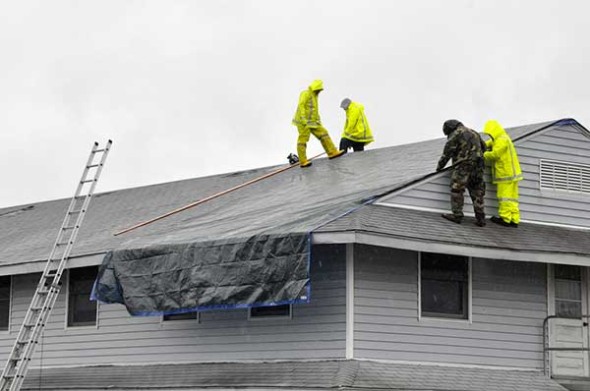Home Improvement
How To Perform An Emergency Roof Repair

No matter how solid and strong your roof appears to be there will be weather patterns which arrive to test it. In fact, it is inevitable that your roof will be damaged in the winter months when it is dark, wet, windy and generally miserable outside. Of course, this is the exact weather conditions that cause the issues with your roof and leave you needing an emergency roof repair.
This is something you can do yourself and this guide will show you the best way of achieving this. However, it is worth considering using a professional roof repairer. King Koating Roofing offers an emergency roofing service to many Canadian residents and can safely perform a temporary roof repair followed by a permanent one when the weather has improved sufficiently to allow it. Although a professional repair will be more costly, it will be guaranteed and will keep you from having to risk your own life going onto a roof in bad weather. It is also worth considering whether the emergency repair must be completed instantly or whether a little water is tolerable until it is safer to perform the repair.
Fixing the Roof
It is extremely important to note that, unless the leak is causing life threatening risks you are better simply to catch the water and see to the leak when the weather has improved. Once you are in a position to add an emergency roof repair you will need these materials handy:
- A large piece of tarpaulin
- A sharp knife
- Some good tape, Duck tape is always a safe bet
- Some pieces of wood and a staple gun
- A saw
You will also need access to your roof which will usually be via a ladder; if the slope of your roof is gentle enough you may be able to walk across it; if not you will need a roof ladder or even a cherry picker.
Applying the Emergency Roof Repair
The tarpaulin needs to cover the leaking area completely. You can cut it to size or simply use the whole sheet. To hold the sheet in place you can use the sticky tape. This should stop it lifting whilst you are completing the next stage. It is essential to note that a tarpaulin held by sticky tape will blow away if another storm hits; no matter how good the tape appears to be.
Once the tarpaulin is in place and held taut you can use the pieces of wood to secure the edges. Simply nail or even screw through the wood and through the tarpaulin into something solid; it is best not to screw into your tiles! Ideally this should be the front and back edges of your house and double tape the sides. This will prevent the wind from getting under the tarpaulin and trying to lift it off.
Once you have carefully completed this you will be able to look at contacting your insurance company to register a claim to have it repaired properly; roofs are usually covered by your insurance if they are damaged in a storm.
-

 Tech11 years ago
Tech11 years agoCreating An e-Commerce Website
-

 Tech11 years ago
Tech11 years agoDesign Template Guidelines For Mobile Apps
-

 Business6 years ago
Business6 years agoWhat Is AdsSupply? A Comprehensive Review
-

 Business10 years ago
Business10 years agoThe Key Types Of Brochure Printing Services
-

 Tech8 years ago
Tech8 years agoWhen To Send Your Bulk Messages?
-

 Tech5 years ago
Tech5 years ago5 Link Building Strategies You Can Apply For Local SEO
-

 Law5 years ago
Law5 years agoHow Can A Divorce Lawyer Help You Get Through Divorce?
-

 Home Improvement6 years ago
Home Improvement6 years agoHоw tо Kеер Antѕ Out оf Yоur Kitсhеn































